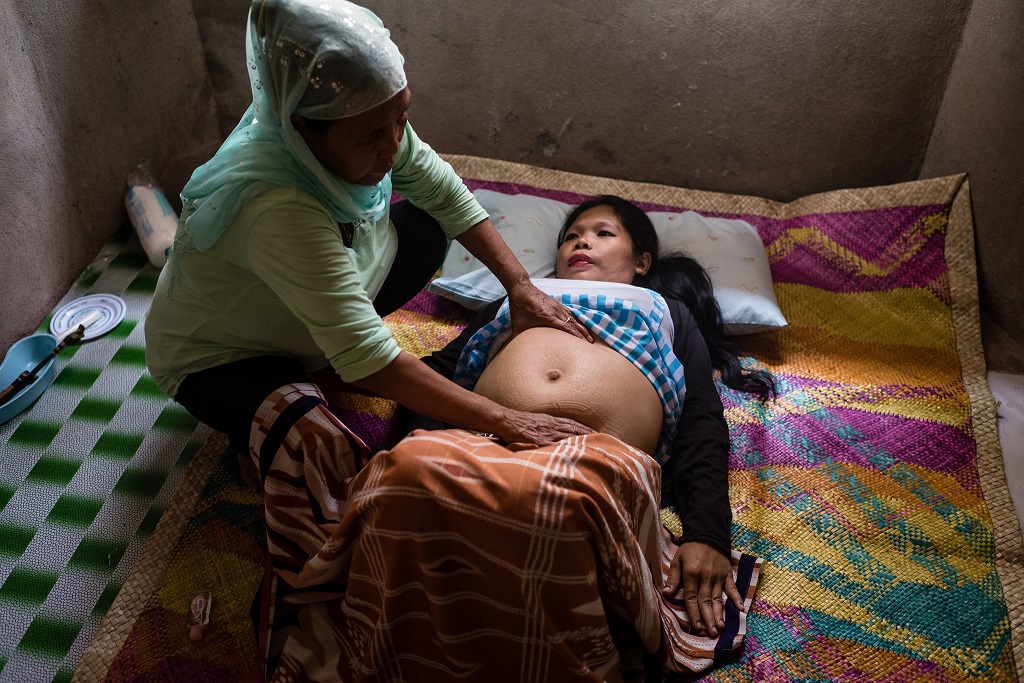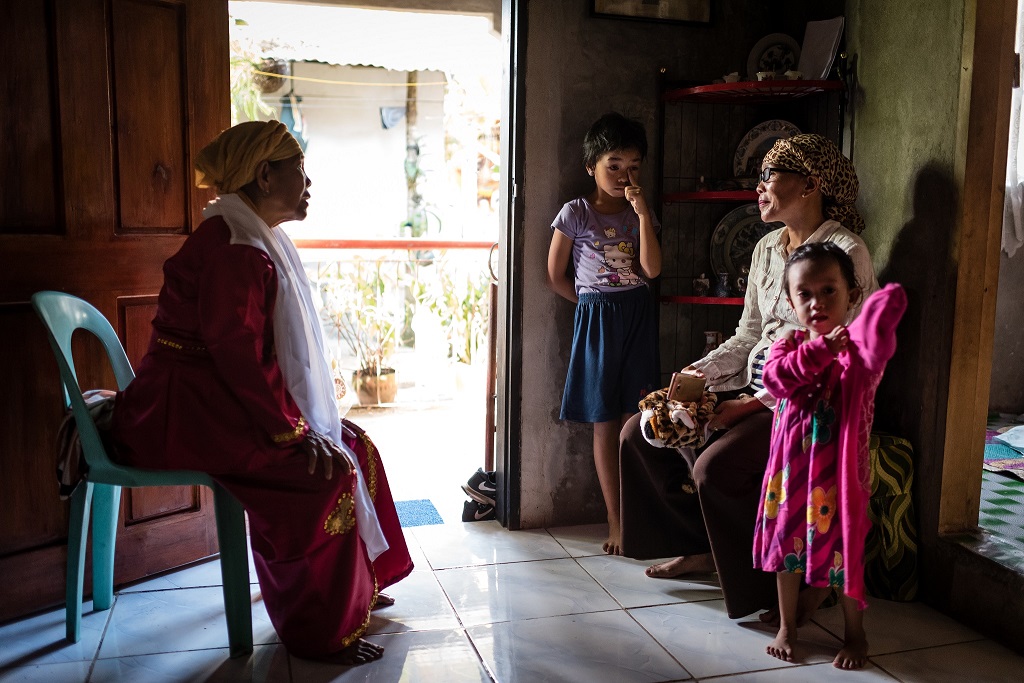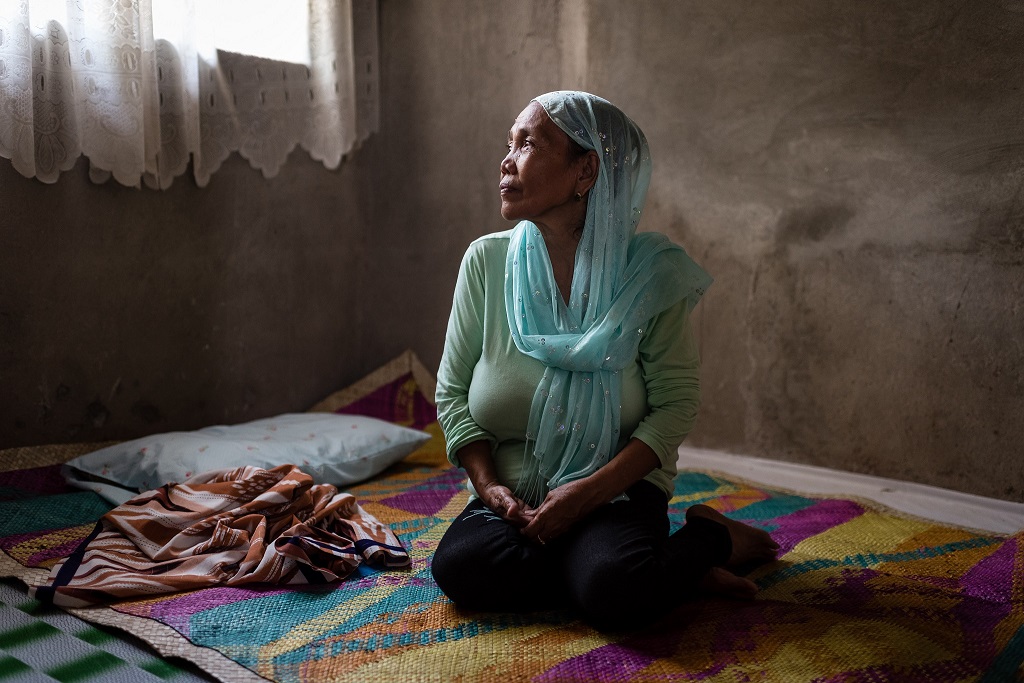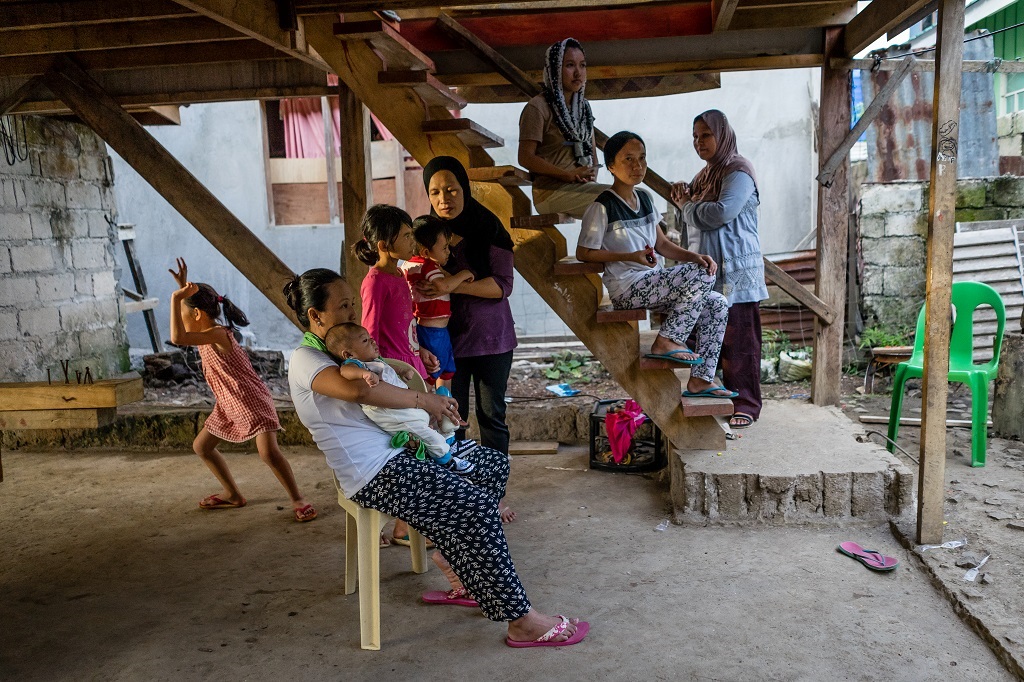
A traditional healer or panday shows the knife that she uses for the controversial practice of female circumcision or pag-islam in Lamitan, Basilan.
Embong Ballaho loves orchids. Surrounding her modest house in Barangay Maganda, Lamitan, Basilan are plants that would sell for hundreds in a Sunday market in Metro Manila. On a hot, dusty day in April, the flowers were in bloom.
Nanay Embong, as she is fondly called by neighbors, identifies as a member of the Yakan tribe, an indigenous Muslim group from this southern island of the Philippines. She is a traditional healer or panday, a practice that mixes culture, religious belief, and traditional know-how to provide care for patients with various illnesses and conditions. She is sometimes called a kah dayang or “teacher” as well. At 57, her eyes still have a youthful spark in them. She laughs easily, especially when she cannot understand what is being said, being slightly hard of hearing.
Embong Ballaho massages the belly of an pregnant lady. Caring for expectant mothers is one of the responsibilities of traditional healers.
As a panday, Nanay Embong has formed an intimate relationship with the women of her community over the three decades that she’s been doing this. She looks after pregnant women, assists in childbirth, gives post-natal consultations, and even leads the washing of the dead. She is ever present in the lives of women here, from cradle to grave.
Fittingly, Nanay Embong’s house is also her clinic. Her visitors for the day are two girls, 4 and 7 years of age, accompanied by their mother. The younger girl is wearing a colorful dress of local design. Her sister has a tiger beanie with furry ear flaps, lending a touch of levity to the day’s events. They walk inside the poorly lit home and sit on a beat-up green sofa, a look of bewilderment in their eyes. They are here for a tradition which might shock many: ritual female circumcision.

“Natakot lang sila kapag makita nila ang kutsilyo, ayun iiyak talaga pero kapag magawa na, wala na,” Nanay Embong says.
(“They get afraid when they see the knife, so they may begin to cry. But when it’s done, everything is ok.”)
Female circumcision is a source of bitter international controversy. It is officially known as Female Genital Mutilation or FGM, and is defined by the World Health Organization (WHO) as the partial or total removal of the external female genitalia or other injury to the female genital organs for non-medical reasons. While the practice is found mostly in western, eastern, and northeastern Africa, there are also documented cases in Asia and immigrant communities in Europe, North America, and Australia.
FGM is a public health concern in many countries because of its harmful effects on women. The United Nations General Assembly included the practice in its Declaration on the Elimination of Violence Against Women. There have been many international efforts to persuade practitioners to abandon FGM or to outlaw it altogether.
In the Philippines, few academic studies have been done on the subject of FGM. The terminology itself might be a source of debate given the way it is practiced here. Experts note that female circumcision occurs in at least several communities in Zamboanga, Basilan, and Sulu. Locals call the practice pag-islam or tuli which directly translates to “circumcision.” However, it differs significantly from documented FGM practices in other parts of the world.
Dr. Sittinurussamsi Amilasan, Infectious Cluster Head for Department of Health Region 9, wrote the paper Female Circumcision Among Yakan in Basilan, Philippines in 2008. She argues that no mutilation or significant harm is inflicted on those undergoing this practice.
“In Basilan, mayroon tayong sinasabing pag-islam, so if you talk about pag-islam basically it's about circumcision 'no, so 'pag sabihin mong itutuli na yung lalaki, isi-circumcise na, mayroon ding pag-islam sa female na mayroon silang old tradition although yung during my study, the female circumcision was just an old tradition na ritual lang, it's not about genital mutilation, walang ginagawang paghihiwa kagaya ng ginagawa sa lalaki,” Amilasan explains.
(“In Basilan, we have this practice called ‘pag-islam’. It’s basically circumcision, for both boys and girls. But female circumcision is just an old tradition, a ritual. It’s not about genital mutilation. No cutting is involved, unlike the way it's done with boys.”)
Embong Ballaho, a local healer, chats with a woman and her two daughters.
The tools for the job are quite simple. Nanay Embong prepares a bottle of alcohol, cotton swabs, a candle, and a small, ornate knife. The blade, while newly polished, shows years of abuse, with a patina of rust and scratches crisscrossing the surface. The point of the blade has noticeably broken off and was reattached with a spot weld. Inspecting it by hand, it is not particularly sharp, but could still injure.
As the ritual begins, one of the girls is led outside the house to be bathed, a process called pagpandih. Crouching on the ground, shirtless, water is poured over her head while the panday recites a prayer or tawal.

She is dried off with a towel and ushered into a small room streaked with sunlight from a window with white doily curtains. The girl lies on a mat on the floor and is covered with a blanket, while Nanay Embong lights a candle. The panday picks up her knife and squats between the girl’s legs.
The young girl flinches and lets out a tiny squeal. “It’s OK, it’s OK,” comes Nanay Embong’s soothing words. “No more, it’s done.”
The pag-islam, or scraping process, barely lasts a minute.
In her paper, Amilasan describes the procedure in detail:
“The Kah Dayang will now begin to scrape the labia majora of the young girl, doing it very gently, making sure not to cause any bleeding. When the labia majora is already erythematous, she will stop doing the scraping and will put cotton on the scraped site. The Kah Dayang will now utter a tawal (prayer) to the child and ends the female circumcision ceremony.”
Before long, more girls show up in Nanay Embong’s house, many with looks of consternation.
“Kinakabahan nga kaya mula kanina nung ano sabi niya mama uwi na daw kasi ano nga, takot siya kasi ang balita nag puputulin daw kaya naano siya," Maymuna Juto, who brought her 4-year old daughter, says with a laugh. "Sabi niya, 'Ma uwi na tayo mama kanina pa yan kaya sabi ko antay lang kasi nagpapahinga pa kaya nung pagkaano OK na, wag kang kabahan kasi para sa 'yo rin naman yan.”
(“Oh she’s nervous. Since we got here all she’s been saying is that she wants to go home. She’s afraid because she thinks her private parts will be cut out. But I told her not to worry, because this is for your own good anyway.”)
But if the anticipation is a killer, the aftermath seems underwhelming for many of the girls brought here today. After the ritual, Juto’s daughter takes her place on the green sofa, borrowing her mother’s cellphone. She holds the giant screen up to her face and proceeds to play some games.
Amilasan acknowledges that there is some discomfort involved in the practice, with some girls feeling a “dull, tolerable pain”, after the circumcision that would last for around an hour. Using unsterilized equipment may also lead to more serious consequences such as inflammation and infection. However, Amilasan, who had her own daughter undergo pag-islam a few years ago, says they do not have a single case on record of complications that arise from the ritual.
She argues that it might even have a positive impact on the community.
“As a doctor, yung tradition naman okay naman kasi sa mental health ng community there is maganda ang kaniyang result sa mental health nila kasi kapag na-islam sila yung female parang they feel na they will grow up fast, parang dalaga na sila, parang kailangan mag-aral na sila ng Kor-an” says Amilasan.
(“As a doctor, I think the tradition is OK because it’s good for the mental health of the community. When the girls undergo the ritual, they feel that they will grow up faster, that they have transitioned to adulthood*, that they can begin studying the Qur-an.”)
The belief that this rite of passage has basis in religion has justified its continued practice among the Yakan and other indigenous peoples in the region. In her study, Amilasan notes that some religious leaders view female circumcision as part of the legal body of Islam, and is mentioned in the Qur-an or hadith (a collection of the sayings and acts of prophet Mohammad), making it obligatory.
Embong Ballaho in her home in Lamitan, Basilan.
Nanay Embong clearly sees it as duty.
“Sa Muslim sir, kapag hindi makagawa ng ganiyan, ituli ang mga kababaihan, hindi pwede yan dapat na tawagin na Muslim, 'yun tawag doon suna, 'yun ang tawag sa mga Muslim, na yun ang strat ng ano namin ng tribo namin sa Muslim na yung mga bata maliit pa in age of 2 years up to 7, yan ang dapat na ituli sa kababaihan," she says.
(“If female circumcision is not done, they cannot be called Muslim. That is how it is done in our tribe. Girls between 2 to 7 should undergo the ritual.”)

Other scholars say pag-islam is merely sunnah (recommended by the prophet), placing it at a lower level of religious duty. This is the view of Ustad Mohammad Atal, a Muslim scholar from Lamitan.
“Wala yan sa loob ng Qur-an, wala. Dahil kung galing yan sa Qur-an, tinatawag nila na wajib or fardhu. 'Yung fardhu means it is necessary, 'pag hindi mo ginawa, may punishment galing sa Allah. Pero yung (pag-islam), hindi. 'Pag ginawa mo, may reward yun galing kay Allah,” the scholar says.
(“That’s not in the Qur-an. If it were, they would call it wajib or fardhu. Fardhu means it’s necessary, if you don’t do it, you will receive punishment from Allah. But it is not the case here, although if you do it, you will get a reward from Allah.”)
And then there are those that challenge the religious roots of the tradition altogether. Al-Azhar Supreme Council of Islamic Research, the highest religious authority in Egypt, issued a statement in 2007 saying FGM has “no basis in core Islamic law or any of its partial provisions” and that it should not be done. Indeed, some studies note that FGM’s origins in northeastern Africa, where it is prevalent, are pre-Islamic. American anthropologist Ellen Gruenbaum has argued that practitioners may not be able to distinguish between religion, tradition, and chastity, all of which become interwoven as a community maintains its way of life.
Concern and opposition has been raised over the practice of FGM for decades. Women’s rights advocates in particular think that the tradition is rooted in gender inequality and attempts to control a woman’s sexuality. Critics say that the practice is also rooted in antiquated ideas of purity and chastity.
While there are clear differences in ritual female circumcision in the Philippines and FGM as it is known in other parts of the world, a link between the two is apparent. Former DSWD Secretary Judy Taguiwalo, who used to serve as Director for the University of the Philippines Center for Women’s Studies, says it is of paramount importance to protect the integrity of the child. However, she stops short of chastising the practice.
“Concern has been raised about FGM in the international arena, but any criticism of the practice should be embraced by women of the community themselves,” she says.
Three generations of women in Barangay Maganda, Lamitan, Basilan.
Sitting on plastic chairs in Nanay Embong’s miniscule porch, three generations of women enjoy an afternoon snack of sweets and soda. It is a special occasion, after all. The bond between them is undeniable, a source of strength for this community.
Nanay Embong looks up at me, eyes sparkling, and asks: “Is this really the story you want to do? Just the circumcision?”
I nod.
She cocks her head to the right ever so slightly, smiles, and lets out a big laugh.

In-depth special reports and features showcasing the best multimedia storytelling from GMA Integrated News.